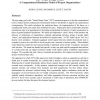Free Online Productivity Tools
i2Speak
i2Symbol
i2OCR
iTex2Img
iWeb2Print
iWeb2Shot
i2Type
iPdf2Split
iPdf2Merge
i2Bopomofo
i2Arabic
i2Style
i2Image
i2PDF
iLatex2Rtf
Sci2ools
CACM
1998
1998
The Virtual Design Team
The long range goal of the “Virtual Design Team” (VDT) research program is to develop computational tools to analyze decision making and communication behavior and thereby to support true organizational (re)engineering. This article introduces the underlying theory, the implementation of the theory as a computational model, and results from industrial test cases. Organization theory traditionally describes organizations only at an aggregate-level, describing and predicting the behavior of entire organizations in terms of general qualitative predictions. We define and implement a “micro” theory of the structure and behavior of components of organizations, explicitly representing activities, groups of people called “actors,” and organizational structure and policies for project teams. A VDT model can be “run” by a discrete event simulation. Emergent aggregate model output behaviors include the predicted time to complete a project, the total effort to do the project, and ...
Behaviors | CACM 1998 | Organization | Theory |
| Added | 21 Dec 2010 |
| Updated | 21 Dec 2010 |
| Type | Journal |
| Year | 1998 |
| Where | CACM |
| Authors | John C. Kunz, Tore R. Christiansen, Geoff P. Cohen, Yan Jin, Raymond E. Levitt |
Comments (0)

